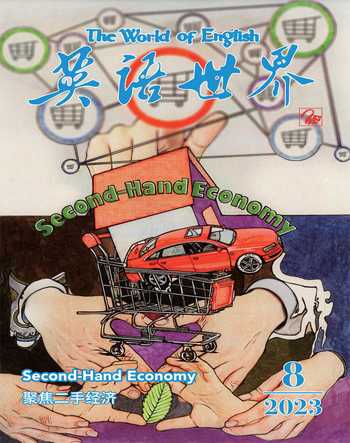A Kind of Blue1此蓝非彼蓝
李小华/译
Environments can affect language—just not in the way you may think.
环境影响语言,但如何影响却非你所想。
Everyone knows the Eskimos have dozens, if not hundreds, of words for snow because of their intimate knowledge of their environment. Except that everyone cannot “know” this, because knowledge requires a statement to be true. In fact, the Eskimo snow story is a factoid2, a word coined by Norman Mailer3 for a fun, roughly fact-shaped object that is not, in fact, a fact—in the same way a “spheroid” is not quite a sphere.
盡人皆知,爱斯基摩人对其生活的环境非常了解,于是他们就有几十甚至几百个表示“雪”的词。只是并非人人都“了解”其中的缘由,因为了解的前提是陈述必须真实。事实上,爱斯基摩人雪的故事是factoid(仿真陈述)。这个词是诺曼·梅勒创造的,指的是一个有趣的对象,貌似事实,实非事实——就像“球状体”不完全是球体一样。
The Eskimos (or Inuit4, as most prefer to be called) dont really have hundreds of words for snow because of their fine sense of its variety. Rather, they have a virtually infinite supply of words for everything, because of the nature of their languages. Inuit languages allow lexical roots to be strung together to make long, highly specific words, including some that might make an entire sentence in English. “Snow that has turned grey from being walked on repeatedly”, a noun phrase in English, might be a single word in Inuit. But the number of basic snow-related roots is not much larger than the number of snow words in English.
爱斯基摩人(又称因纽特人,他们大多更喜欢这个称呼)有数百种表示“雪”的说法,这其实并不是因为他们能精细感知各种各样的雪。确切地讲,无论说到什么东西,他们几乎都有数不清的词来指代,这是其语言特性使然。因纽特语能把词根串连成表意极为精确的长单词,其中有些用英语说可能得说完整的一句话。比如,在英语中“因反复踩踏而变成灰色的雪”是个名词短语,而在因纽特语中可能只是一个单词。但是,有关“雪”的基本词根个数并不比英语中表示“雪”的单词数多太多。
For many linguists, the Eskimo snow story has become an example of an embarrassing, exoticising fairy tale about an unfamiliar culture, passed round by those who know nothing of it. It is also the paradigmatic5 example of assuming a kind of mystical connection between language, land and culture—which falls apart6 under serious scrutiny.
许多语言学家认为,爱斯基摩人雪的故事俨然就是那种令人尴尬的异域童话,讲的是陌生文化,由一些并不了解这种文化的人散播开来。这还是某种观点的典型表现,即认为语言、地域和文化之间有某种神秘联系——其实这种关联经不起仔细推敲。
Today, efforts to draw links between language and the environment are more respectful. One linguist has observed that languages with certain rare consonants (called ejectives7) are more prevalent at high altitudes, perhaps because those are easier to pronounce in lower air pressure. Another team found that languages which use tones (ie, changes in pitch) in their vowels, to distinguish one word from another, are linked with humid climates. This is purportedly because humidity helps the vocal folds produce the tones. These causal relationships are not always accepted by other scholars.
如今,找出语言与环境之间关联的努力更尊重现实。一位语言学家发现,带有某些罕见辅音(称为挤喉音)的语言在高海拔地区更为普遍,也许是因为气压较低时这些辅音更容易发出来。另一研究团队发现,以元音声调(即音高变化)区分单词的语言与潮湿的气候有联系。据说,这是因为气候潮湿利于声带发出各种声调。上述因果关系并非总是得到其他学者的认同。
Recently, though, a large study of colour words around the world has found a clear link between geography and vocabulary. Colour is a classic case of a spectrum. There is no sharp break8 between, say, blue and teal9, and cultures divide the continuum10 in different ways. Some languages have just two colour-related words, for light and dark. A pair of linguists, Brent Berlin and Paul Kay11, wrote in the 1960s that if they have a third, it is almost always for red; a fourth and fifth are usually for green and yellow.
然而,最近有一项针对世界各地颜色词的大型研究发现,地理环境和词汇有着明确关联。颜色是谱系的一个经典案例。比如,蓝色和绿蓝色无明显差别,不同文化对这种渐变色彩的区分方式各异。有些语言只有两个词与颜色有关,分别代表浅色和深色。布伦特·伯林和保罗·凯这两位语言学家在1960年代著书指出,语言中若有第三个颜色词,那往往是红色;若有第四个和第五个词,那一般是绿色和黄色。
Blue comes only sixth in the Berlin-Kay schema12, elementary as it may seem. Besides the sky and sea, though, there are few blue things in nature, which may make the word less necessary; rarely does anyone say “look for a blue plant”, because these are uncommon. Many languages lump together blue and green, a chunk of the spectrum linguists call “grue”13.
根据柏林-凯的纲要,蓝色仅位列第六,尽管它似乎是基础色。然而,除了天空和海洋,自然界中几乎没有蓝色的东西,这使得蓝色这个词也就不怎么有用。很少有人说“寻找一种蓝色的植物”,因为蓝色植物很少见。许多语言把蓝色和绿色混为一谈,语言学家称色谱中的这一区域为“绿蓝色”。
The new study breaks ground by finding that there is indeed a link between the use of grue words and the environment, specifically sunshine. Populations exposed to lots of sunlight are more likely to talk about “grue”, note Mathilde Josserand, Emma Meeussen, Asifa Majid and Dan Dediu14. One possible reason is that long-term exposure to ultraviolet light can cause changes in the retina that make it more difficult to distinguish blue from green.
此项新研究取得了突破,它发现表示绿蓝色的词,其使用与环境(具体指阳光)确有联系。玛蒂尔德·若斯朗、埃玛·梅乌森、阿西法·马吉德和丹·德迪乌指出,生活环境阳光充足的族群更有可能谈及“绿蓝色”。其中一个可能的原因是,长期接受紫外线照射,视网膜会发生种种变化,分辨绿色和蓝色愈加困难。
The researchers tested a host of other theories to account for the presence of a “grue” term, and found a weaker but still interesting link to culture, rather than physiology. They discovered that larger populations were more likely to have a distinct “blue”. Population size, they speculate, is a reasonable proxy15 for cultural complexity—the kind, for instance, that would lead cultures to develop dyeing techniques, and thus create artificially blue objects.
研究人員对其他许多理论做了检验,以解释表示“绿蓝色”的词存在的原因,他们找到了这些词的产生和文化之间的联系,尽管弱于同生理机能之间的联系,但依然值得关注。研究人员发现,人口规模越大,出现单独表示“蓝色”的词的可能性就越大。他们推测,人口规模是文化复杂性的可靠指标,比如说,这种复杂性会导致文化群体改进染色技术,进而造出人造蓝色的物品。
This is the first study to test so many of these hypotheses to see which hold up16 best. That is an admirable approach, which reduces the chances of a coincidental finding, the type that pops up all the time when researchers scour databases looking for linked variables. (One such effort found a link between acacia trees and tonal languages, a connection rather difficult to explain.)
这是首次有研究检验如此多假设以确认哪个假设最能站得住脚。这种方法值得赞赏,可以降低偶然结果的概率——研究人员搜索数据库寻找关联变量时,总会出现这种偶然结果。(有这样一次搜索就发现刺槐和声调语言有联系,但这种关联难以解释。)
The limitation is that the thing being tested (such as whether there is a distinct word for “blue”) must be quite simple, in order to compare widely varying languages. But the strength of this method is that it produces conclusions which, if you drop them into cocktail-party conversation, are more likely to be legitimate. Fun facts are only really so when they are, indeed, facts.
这种研究方式的局限在于,为了能比较相差悬殊的不同语言,检验的项目(如是否有确切表示“蓝色”的词)必须非常简单。但这种方法的优势是,如果在鸡尾酒会与人交谈时提及,所得结论合理的可能性更高。趣事为真,方为有趣。
(译者为“《英语世界》杯”翻译大赛获奖者,单位:青岛科技大学外国语学院)
1即指正文中的grue(绿蓝色)。 2梅勒于1973年在《玛丽莲》(Marilyn)一书中用fact加后缀-oid(像,类似于)构成的派生词,指“在杂志或报纸上出现之前不存在的事实,所造事实与其说是谎言,不如说是操纵沉默的大多数人情感的产物”(facts which have no existence before appearing in a magazine or newspaper, creations which are not so much lies as a product to manipulate emotion in the Silent Majority)。 3(1923—2007),美国小说家,代表作有《刽子手之歌》(The Executioners Song)、《裸者与死者》(The Naked and the Dead)等。 4北极地区土著人,Inuit是他们的自称,义为“人类”。Eskimo为旧称,义为“生食者”,现趋弃用。
5 paradigmatic典范的。 6 fall apart破碎,瓦解。 7 ejective(语音学)挤喉音。
8 break突变,中断。 9 teal = teal blue(凫蓝,绿光暗蓝色)。 10 continuum(相邻两者相似但起首与末尾截然不同的)连续体。 11这两位学者在《基本颜色词语:普遍性与进化论研究》(Basic Color Terms: Their Universality and Evolution, 1969)一书中,比较研究了近100种语言,概括出11种颜色词语,按其包容关系依次为:黑(black)、白(white)、红(red)、绿(green)、黄(yellow)、蓝(blue)、棕(brown)、紫(purple)、橙(orange)、粉(pink)、灰(gray)。作者认为,这11种基本颜色词(basic color terms)普遍存在于各种语言中,这是由于人类的视觉生理系统对某些颜色特别敏感,促使感性范畴在语言中反映出来。这一基本颜色词普遍性原则表明,不同语言交流中颜色词的语义存在着对应关系。 12 schema (计划或理论的)提要,纲要。
13由green和blue构成的缩合词。 14诸位学者于2021年9月在英国《科学报告》(Scientific Reports, Volume 11)上刊文“环境和文化塑造颜色词汇和色觉遗传”(Environment and culture shape both the colour lexicon and the genetics of colour perception),對蓝色词的产生因素进行了定量研究,认为理解语言间的差异必须依靠各语言的文化、生物和物理环境体系(variation in languages can only be understood in the context of their cultural, biological, and physical environments)。 15 proxy(测算用的)替代物,指标。
16 hold up(论点、理论等)站得住脚,经受得住检验。

